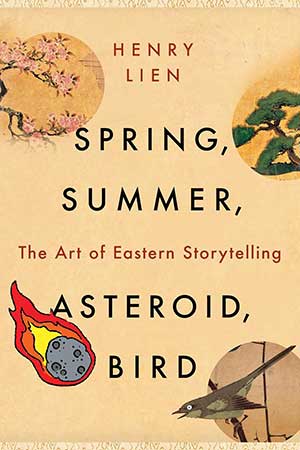Understanding Jap Storytelling in Henry Lien’s Spring, Summer time, Asteroid, Chook, by Lala Mammadova

If in case you have ever taken a writing class in Europe or North America (aka the West), you have got possible heard in regards to the three-act construction. Story parts just like the inciting incident, pressure, central battle, climax, and backbone have develop into virtually unquestionable staples of fine storytelling and will be present in each film or novel. Henry Lien, the writer of Spring, Summer time, Asteroid, Chook: The Artwork of Jap Storytelling (Norton, 2025), invitations readers to use a brand new lens to storytelling and introduces us to the four-act construction of Jap tales.
 Lien writes speculative fiction and teaches writing within the Writers’ Program at UCLA Extension. Based on his web site, he was born in Taiwan and now resides in California. This bicultural perspective is clear all through the e-book in Lien’s understanding of how tales are structured and consumed throughout cultures.
Lien writes speculative fiction and teaches writing within the Writers’ Program at UCLA Extension. Based on his web site, he was born in Taiwan and now resides in California. This bicultural perspective is clear all through the e-book in Lien’s understanding of how tales are structured and consumed throughout cultures.
Lien explains the Jap four-act construction by way of a brief story titled “Spring, Summer time, Asteroid, Chook,” with every phrase within the title signifying one of many acts (Act One – Spring, Act Two – Summer time, and so forth). All through the e-book, he breaks down movies, novels, video games, and even poems from Jap cultures or written by Jap authors that observe this construction. A few of the well-known titles Lien analyzes embrace the flicks Parasite, Every part All over the place All at As soon as, and Rashomon, the novels Arduous-Boiled Wonderland and the Finish of the World, By no means Let Me Go, and the sport The Legend of Zelda. A lot of the analyzed works come from East Asian traditions, resembling China, Taiwan, and Japan, with some uncommon examples from Indian and Center Jap literature. One among his central claims is that Western audiences and readers do love and perceive the four-act construction regardless of generally held beliefs on the contrary.
Lien breaks down movies, novels, video games, and even poems from Jap cultures or written by Jap authors that observe this four-part construction.
The e-book challenges Western media’s try so as to add range to their films by casting exotic-looking actors or setting tales in superficially Jap places. His major instance is Disney’s live-action Mulan. He argues that including Jap aesthetics isn’t sufficient to inform Jap tales and that creators should perceive traditions, values, and themes that form Jap storytelling. This sort of cultural evaluation is without doubt one of the recurring subjects of the e-book. Earlier than diving into the four-act construction, the writer additionally breaks down the Western three-act construction and generally rewrites the four-act tales into three-act tales to reveal the distinction. Within the e-book’s third chapter (or act), Lin discusses collectivism versus individualism and exhibits how values form what story buildings prioritize (for instance, asymmetry over symmetry).
One of many greatest takeaways from the e-book is the third-act twist marked by the arrival of the asteroid. This twist may manifest by means of the addition of a brand new aspect, a change in tone, and even the style. Lien’s clarification of this twist, though easy, provides a recent lens on tales like Parasite, the place the second half of the story shifts into one thing unfamiliar but compelling.
That being mentioned, the e-book can generally homogenize Jap traditions by grouping a wide range of cultures—Chinese language, Taiwanese, Japanese, Indian, and Center Jap—beneath the umbrella time period “Jap.” There’s additionally an occasional tendency to view Jap and Western storytelling in a binary approach, and the comparability can often really feel reductive of Western storytelling. Nonetheless, the writer appears conscious that some elements of the e-book will be perceived as such and steadily addresses these points.
The e-book demonstrates a great stability between theoretical dialogue and case research. This isn’t a standard writing-craft guide, so don’t anticipate any writing prompts or do’s and don’ts of writing. Nonetheless, writers may discover some concepts to experiment with. Neither is it a deep, tutorial exploration of Jap literature, traditions, and historical past. The e-book is what it says it’s: an introduction. Lien’s language and strategy are accessible and interesting. It’s geared toward normal audiences, primarily Western readers, who love studying throughout cultures and watching Miyazaki films.
Norman, Oklahoma

0 Comment